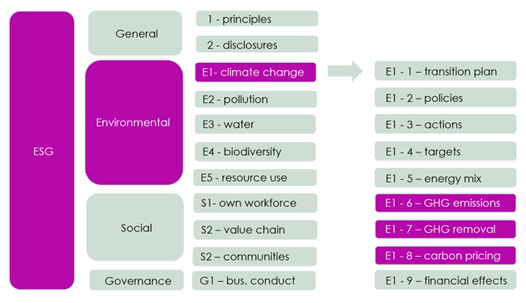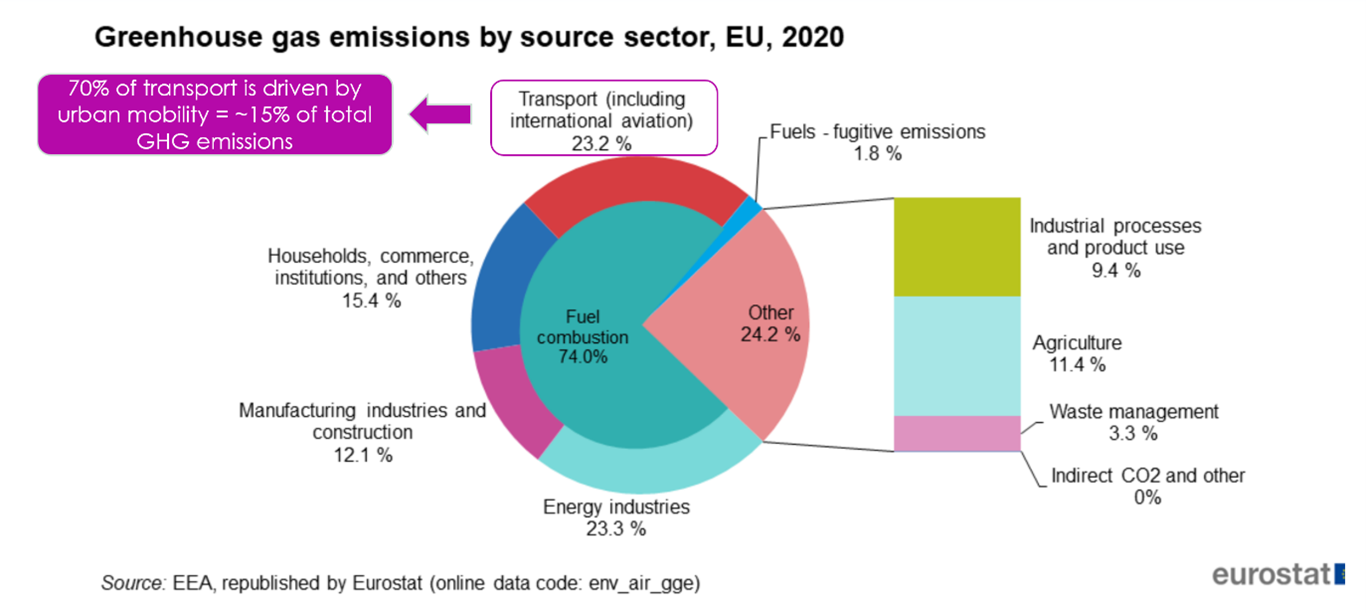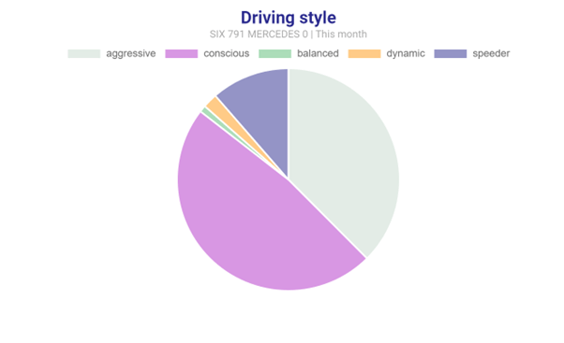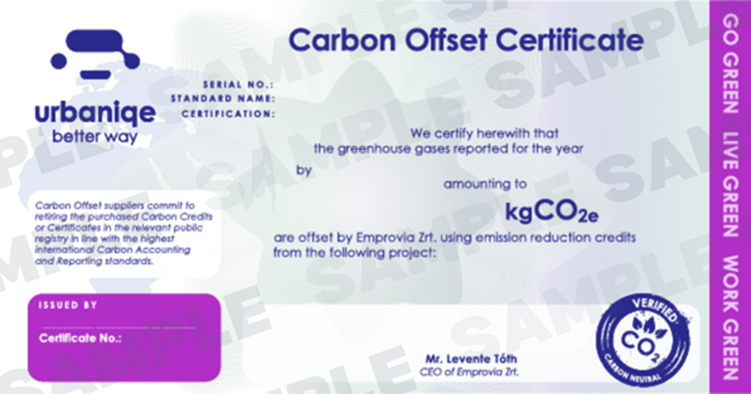Sustainability compliance of businesses in urban mobility
ESG (Environmental, Social, Governance) compliance is increasingly becoming the focus of corporate strategies as the world's attention turns to the environmental and social impacts of business activities. ESG factors can create business value on their own, but more importantly, they promote the future of our planet and society. In this context, the European Union took a big step to promote sustainability with the introduction of the Corporate Sustainability Reporting Directive (CSRD), as part of which the European Sustainability Reporting Standard (ESRS) was recently created. In this article, we would like to give a brief overview of the topic, with a particular focus on mobility aspects and how Urbaniqe helps its customers with ESG compliance.
The Corporate Sustainability Reporting Directive (CSRD) as a directive is to provide external stakeholders with uniform, accurate, reliable, and comparable information on the sustainability performance of companies in all EU member states. The directive requires companies to apply certain standards to fulfill their legal obligations regarding sustainability reporting. The purpose of community standardization is for companies in the European Union to report comparable and reliable sustainability information. In this way, the standards help companies to manage and communicate their sustainability performance more effectively. The ESRS, as a set of sustainability standards, was adopted on July 31, 2023, and must be applied by large and medium-sized companies that fall under the scope of the CSRD.

The European Sustainability Reporting Standard (ESRS) introduces reporting standards that define exactly how companies must report on their environmental and social impacts. One of the key areas of the ESRS is the ESRS E1 standard, which focuses on tasks related to climate change and the mitigation of its risks and effects. In this context, one of the important aspects of the tasks is the reduction of greenhouse gas (GHG) emissions, which is expressed in CO2e (equivalent) measurement units. The transportation and logistics industry is responsible for 23% of the GHG emissions in the EU, within that urban mobility accounts for approximately 70%, which is around 15% of the total GHG emissions.

Urbaniqe, as a sustainability service provider primarily focused on urban mobility, actively supports its corporate partners in the ESG area, especially in achieving compliance with the ESRS E1 standard. The support process takes place in several stages:
1. The primary goal is to reduce CO2 emissions by 15% with the help of green fleet management!
The first step in ESG compliance is always the reduction of the carbon footprint. Urbaniqe helps its corporate customers in the management of their vehicle fleet, primarily in the optimization of mileage and specific fuel consumption, which, in addition to cost reduction for mobility purposes, also serves sustainability, reducing GHG emissions by about 15%. But how can all this be achieved?
- In the case of company vehicles, the excessive use of cars for private purposes can be observed everywhere worldwide, which causes a significant excess of emissions. Here, there is an obvious conflict of interest between the company and the employees who also use the vehicle for private purposes. Therefore, we do not recommend an absolute ban on private use, because it can lead to inefficient and unnecessary fluctuations, which are contrary to other goals of ESG. However, with the systematic and consistent separation of corporate and private use and the conscious management of related policies, the mileage of the vehicle fleet and thus GHG emissions can be reduced by approximately 10%.
- In addition to rationalizing mileage, educating drivers and improving their driving style is also a crucial factor as part of the feedback culture. With the help of a suitable and transparent driving style, average consumption, and CO2 emission reports, the specific fuel consumption and thus the GHG emissions can be reduced by another 5%.
- If we have already achieved a 15% reduction in GHG emissions (and with it a similar volume of fuel savings!), then in order to comply with ESG, it is only necessary to report this in an appropriate manner, which ESRS E1 reporting is collected in a closed system by the Urbaniqe service and displayed transparently provides data and automatic reports.

2. We decarbonize the remaining carbon footprint in a better way with carbon credits!
The CO2 emissions of combustion engine fleets obviously cannot be reduced to zero without a technology change, if it is necessary to use the cars to achieve our business goals. This is where Urbaniqe enters the picture again, which offers the opportunity to make the remaining 85% of emissions carbon neutral with the help of carbon credits. But how does all this work in practice?
- First, let's clarify what a carbon credit is. A carbon credit is a financial product available on the voluntary carbon market that represents a permit whose owner is entitled to offset 1 ton of CO2 emissions. This is possible because the project through which the given carbon credit was created has been authentically proven to reduce global greenhouse gas emissions by 1 ton in CO2e equivalent terms. The projects - during the implementation of which carbon credits may be generated - must meet strict conditions to be able to issue their past carbon dioxide savings as carbon credits. The owner of the credits also assumes legal responsibility and guarantees that the amount of CO2 represented by the credits has been saved physically before the credits are issued. These conditions and authenticity are checked and verified by the companies and civil organizations operating the voluntary carbon market system.
- Customers can obtain carbon credits within the Urbaniqe application by making an in-app purchase if they wish to offset their remaining carbon footprint after the reduction. Urbaniqe currently determines the number of credits required for compensation based on the refueling receipts recorded in the system, however, compensation calculated based on the CO2 emissions of the specific driving performance will soon be available as well in the Urbaniqe application.
- Urbaniqe issues a carbon offset certificate for carbon footprint compensation transactions realized with the help of carbon credits, which certificates are included in the transparent international registers. This certificate not only ensures ESRS E1 compliance but is also an auditable, internationally registered document with strict emission serial numbering, which certifies the sustainability solution provided by Urbaniqe and the ESG compliance of the customer who purchases it.
Transactions conducted by Urbaniqe are available at https://www.urbaniqe.com/carbonoffsetcertificates . - It is also important to know how much this compliance costs customers. For this, we created a calculator where anyone can easily calculate the cost of decarbonization based on the value of their refueling: https://www.urbaniqe.com/dekarbonzation-calculator . As a rule of thumb, it can be said that in the case of a company fleet of gasoline-powered passenger vehicles, the cost of decarbonization is practically fully covered by the 15% savings provided by green fleet management, but everyone can verify this personally for their fleet on the following page: https://www. urbaniqe.com/roi-calculator

3. Is there more?
Of course, there is! The Urbaniqe team is currently working to provide financial assistance to its customers as they replace their end-of-life internal combustion engine fleet with electric vehicles. We want to support the technological change with the emission of carbon credits based on the CO2 emission reduction released from it, but we will talk about this in our next article so that there will be excitement about the continuation in the meantime!
The solutions offered by Urbaniqe thus jointly contribute to the sustainable development of companies and the protection of the planet. With its innovative and efficient services, Urbaniqe wishes to become a long-term partner of its corporate clients in fulfilling ESRS E1 requirements.
You may also like
Related stories
.png)
A small step for small businesses, a big step for the environment - how to set sustainable development goals?

From Traditional to Modern - Comprehensive Solutions to Reduce Emissions Alongside Classic Practices
